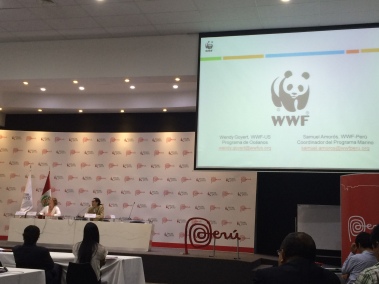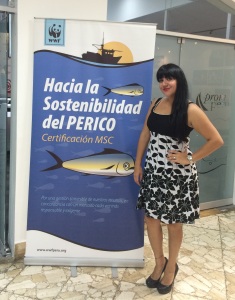First Peruvian Mahi-Mahi Fishery Improvement Project (FIP) Progress Review meeting
May 7-8, 2015 Lima, Peru
This two day meeting was facilitated by Antonio Hervás Abad, ASI Lead Assessor & Fisheries Specialist, and consisted of presentations by Juan Carlos Requejo, Vice Minister of Fisheries (PRODUCE), Juan Carlos Riveros, Director of Conservation (WWF- PERU), Wendy Goyert (WWF-USA) and Samuel Amorós (WWF-PERU), Santiago de la Puente- Intelfin Consultant, Carlos Manuel Arca Hoyle (PROMPERU), Miguel Ñiquen (IMARPE), and Alberto Abanto (AAARCUDIPA).
FIP TIMELINE:
- 2012 Identify fishery’s key stakeholders
- Jun-Dec 2012 MSC Pre-assessment
- Jan-Feb. 2013 Outreach of the FIP
- Mar 2013 Meeting with key stakeholders/development of work plan
- 2013- Present Implementation, Revision and Evaluation
Wendy Goyert, WWF USA and Samuel Amoros, WWF Peru answer questions after providing a presentation update about the FIP
MEETING SUMMARY- HIGHLIGHTS
- This FIP is a collaborative process which helps improve access to American market
- Working with producers to have the tools to respond to new demands is crucial for maintaining market relevance
- Establishment of fishing season: October 1- April 30
- Studies show the numbers of juvenile caught increases May-September reaching 46.2% and decreasing by February
- Establishment of Minimum Landing Size: 70 cm in length from nose to fork
- It was also noted that Ecuador uses 80 cm total length
- Need to be more flexible and efficient in the decision making process. The role of WWF is to provide information and facilitate the dialogue between sectors. Their mission is the protection of the resource and to promote the equal access to it.
- More than the 50% of mahi-mahi catch worldwide is from Peru
- 69 activities were identified to help improve the fishery:
- Stock health. i.e. minimum size
- Ecosystem impacts such as shark retention. In Peru there is no shark finning and turtles are returned if captured. Question of ghost gear.
- Effective management
- Creation of a National Technical Group for the mahi-mahi fishery
- Participated in the first Bi-national Workshop (Ecuador/Peru) for the mahi-mahi, September 2014
- Participated on the first International Technical Workshop for the mahi-mahi organized by the ICCAT on Oct 2014
- Develop a program for the use and implementation of logbooks
- Observer program for biological data collection
- Work towards the development of National a National Action Plan for the conservation and management of the mahi-mahi in Peru
- WWF makes recommendations, meets with government agencies to evaluate existing regulations
- If able to advance all the activities in the action plan, they are hoping to enter certification in 2017
- Website is now available in Spanish- proyectoperico.org
Adriana Sánchez, Sea Delight Ocean Fund President and Sustainability Coordinator at Sea Delight, gave a short presentation about the importance of seafood sustainability in the U.S. market
WORKPLAN 2014-2015
- Consolidation and internal organization of the National Technical Group (GTN- Grupo Técnico Nacional)
- Strengthen the onboard observers program
- Expand data collection during the mahi-mahi season 2014-2015
- Share publications in regards to the mahi-mahi
- Standardization of formats and reports
- Development of a census of the fleet participating in the fishing of mahi-mahi
- Promote the research process
- Participation in international meetings
OBJECTIVES
- Generate fishery information that could be used for the management
- Knowledge and registration
- Data processing: catch-per-unit-effort (CPUE), distribution maps and fishery focus, etc.
- Generate a registration of the mahi-mahi fisher’s work and create a platform to channel events that occurred onboard of these vessels: bycatch, lost gear, etc.
- Contribute to the consolidation of the fishers’ roles in the generation of knowledge of this resource and their fishery with the goal of contributing to its management.
CURRENT STATUS OF THE MAHI FISHERY: SOCIAL AND ECONOMIC CONSIDERATIONS
- In 2009 the mahi-mahi fishery generated:
Employment opportunities:
- At sea- 6023
- In land- 10,706
- Multiplier 1.78
Contribution to the GDP
- At sea, USD 67.4 million
- In land, USD 137.5 millions
- Multiplier 2.04
- TRENDS IN EFFORT
- Increase in fishing effort of the artisanal fleet: more artisanal fishers, vessels, capacity for storage, length of longline, increase in number of hooks, effective fishing dates and duration of the fishing labor.
- The increase in fishing efforts has not been accompanied by an increase in quality (the poor isolation of the storage units in the fleet makes the practice not cost-effective if the resource is not close to the coast)
GROUP DISCUSSION HIGHLIGHTS
- Fisher’s representatives emphasized the need for better price at landing
- Focus on training workshops for fishers to generate support on the use of logbooks and on-board observer programs
- Focus on technical workshops for fishers. Use social media, webinars, to disseminate information and reduce cost
- Discussion on the use of technology for the on-board observer programs in addition to a physical presence. There are many financial and technological difficulties to address.
- Need to put emphasis on a rule to minimize discards and provide an incentive to declare the complete catch so that data can be collected on mahi-mahi and all impacted species. This information is crucial for making good decisions.
- Measurable progress needs to be made soon. It is also vital that this progress and all relevant project information be publicized to help maintain confidence and support for this FIP throughout the supply chain.


